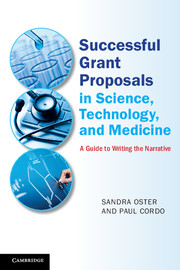Book contents
- Frontmatter
- Dedication
- Contents
- Preface and Acknowledgments
- 1 The Scientific Grant Proposal and Its Narrative
- 2 The Aims Section
- 3 The Background Section
- 4 The Preliminary Studies/Progress Report Section
- 5 The Methods Section, Part 1
- 6 The Methods Section, Part 2
- 7 Other prose considerations
- 8 Technical features of sentences
- Glossary
- Index
- References
2 - The Aims Section
Published online by Cambridge University Press: 05 September 2015
- Frontmatter
- Dedication
- Contents
- Preface and Acknowledgments
- 1 The Scientific Grant Proposal and Its Narrative
- 2 The Aims Section
- 3 The Background Section
- 4 The Preliminary Studies/Progress Report Section
- 5 The Methods Section, Part 1
- 6 The Methods Section, Part 2
- 7 Other prose considerations
- 8 Technical features of sentences
- Glossary
- Index
- References
Summary
The Aims Section is the first major prose section in the narrative of a scientific grant proposal. Some funding agencies call this first section the Introduction. The Aims Section provides the conceptual framework for the proposed research in the sense that it introduces the proposed research topic or research area, the significance and novelty of the proposed research, the purpose of the proposed research, the proposed methodological approach, and the proposed aims. What is called the aims in this book is variously called objectives or specific aims by different funding agencies.
Figure 2-1 shows the basic layout of the Aims Section. Figure 2-2 shows the relationship among the long-term goal, the research objective, and the aims in the Aims Section. Cases 2-1 and 2-2 show Aims Sections from the narratives of scientific grant proposals addressing basic research; Case 2.3, applied research; and Case 2.4, clinical research.
Overview of length, content, organization, and layout
The Aims Section ranges from one-half page to 2 or 3 pages, depending on submission requirements and on the overall length of the narrative. Different funding agencies have different requirements for the Aims Section. In most cases, NIH requires that its first section of the narrative, which it terms the Specific Aims Section, not be longer than one page.
- Type
- Chapter
- Information
- Successful Grant Proposals in Science, Technology, and MedicineA Guide to Writing the Narrative, pp. 36 - 67Publisher: Cambridge University PressPrint publication year: 2015



